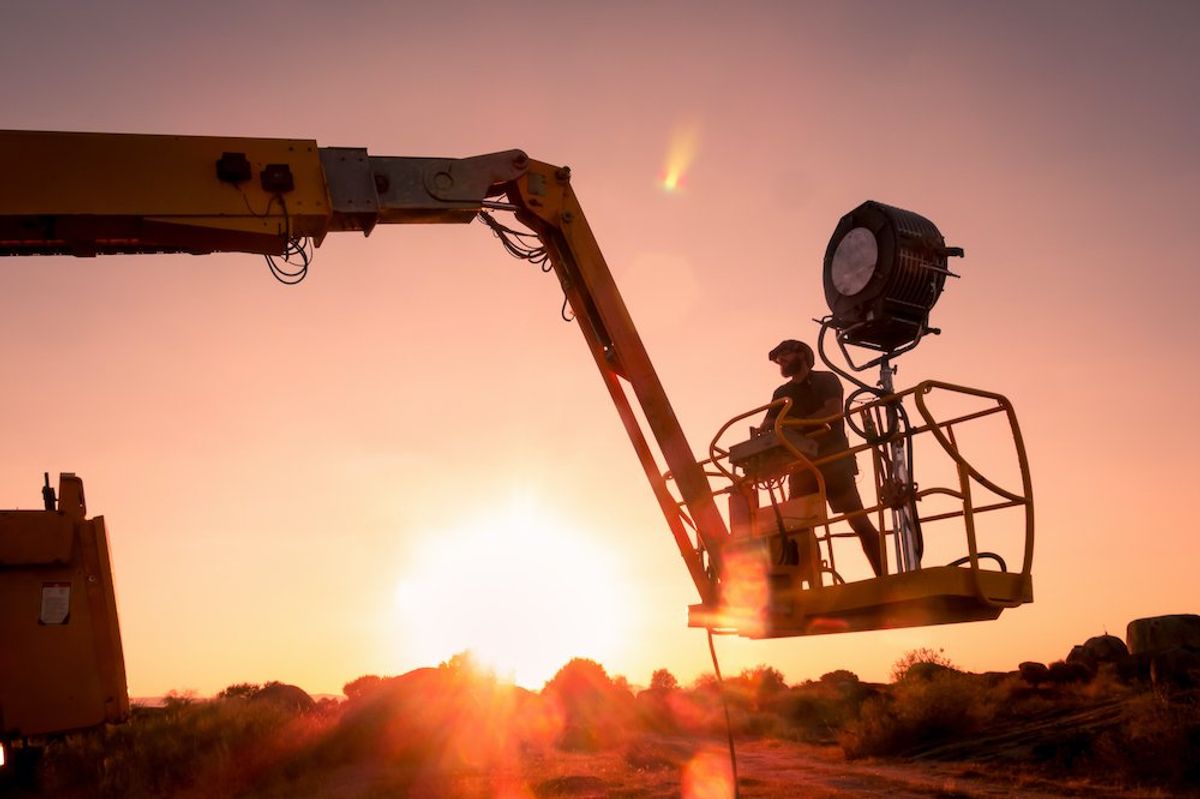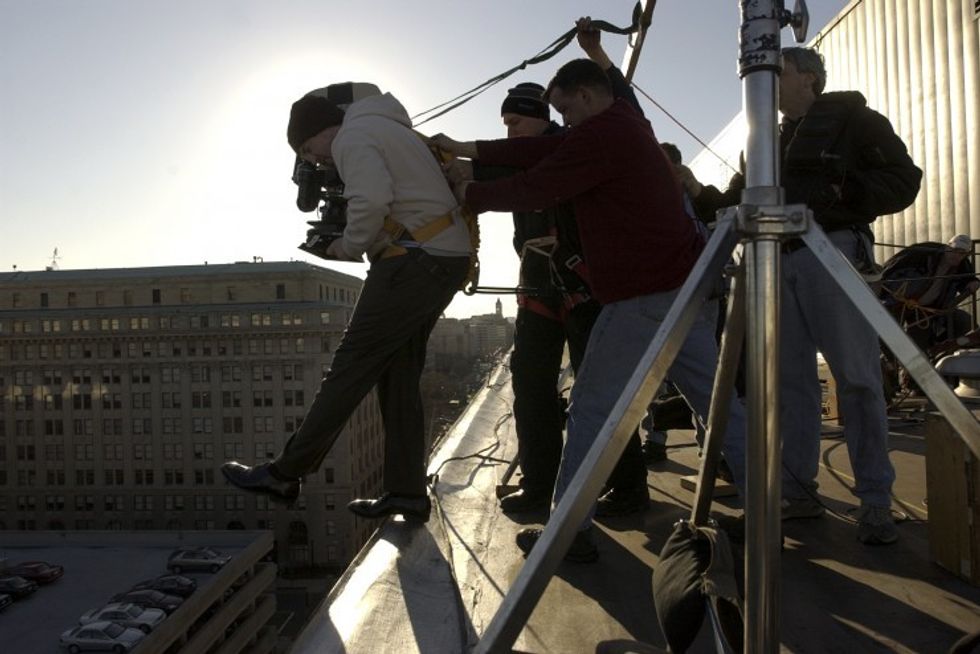
Think back to when you first began dreaming about a life in movies. Did you hope to be a director? Producer? Writer? Cinematographer? Gaffer–Wait, what?
Now, I’m not sure how many of you out there lay awake in bed obsessing over becoming the chief electrician on a film set, but I do know that not many people new to the industry know all that much about what gaffers are or what they do. And you should know, whether you become a cinematographer who depends on the gaffer to set up lights or you start your career in the electrical department.
Today, I wanted to go over the job of the gaffer and dig into their role on set, who they interact with, their relative pay, and why they’re so important to film and television.
We will bring in real gaffers to talk about the job and look into how their role in the electrical department is crucial to the final product.
Ready?
Let’s get gaffing.
Lights, camera, action!

What does a gaffer do?
The gaffer definition is as follows… On film and television crews, the gaffer, or chief lighting technician, is the head electrician. Gaffers are responsible for coming up with a plan to light every scene in your movie or TV show. They have to know every detail about the production and work in concert with the cinematographer and director to help achieve a consistent look and feel.
Hollywood gaffers are part of the IATSE Local 728 Studio Electrical Lighting Technicians Union.
Why are they called gaffers?
Why are they called gaffers?
The term “gaffer” hasn’t always been tied to the film industry. Etymologically, the word, meaning “elderly rustic”, dates back to the 1580s and was used as a contraction of “godfather”. Later on in history, “gaffer” extended to refer not only to “old men” but foremen and supervisors.
Additionally, the term “gaff” dates back even further to the 1300s, and was originally used to refer to an “iron hook” used for rigging boats.
“Gaffer” eventually made its way into the film industry to refer to the moving of overhead equipment to control lighting levels using a gaff, then, finally, to the “electrician in charge of lighting on a film set.”
How do you get a gaffing job?
Most gaffers begin life as set electricians or production assistants. They need to learn about lighting choices and schemes to work their way up. As they learn those jobs, they also learn set management as well as all the ins and outs of electricity.
They have to ensure there is ample electricity for a whole array of uses on a film set and figure out the watts and amperage necessary to keep everything working.
It’s also important to have a close working relationship with the cinematographer. They are usually the ones who hire this department.
Grip vs. Gaffer, or Gaffer vs. Grip
When I began writing this article, I met a little confusion here, so I wanted to clear up the roles.
As you now know, the gaffer is the head electrician in a movie crew. It’s their job to manage the lighting, making sure the levels are appropriate for the desired effect in the scene. The assistant to the gaffer is the best boy electric and an entire crew of electricians.
The grip is a different role. While they are also involved with lighting, they come at it from the mechanical side. Grips handle shading, filters, nets, flags, or other objects in front of lights, or setting up large frames or tents to block the sun. Grips are like a construction crew, responsible for the setup and stability of scaffolds, ladders, and other heavy objects. The head grip is called the key grip.
The gaffer and grip will often work in tandem, but they do different jobs.
Define gaffer tape
Gaffer tape (also known as gaffer’s tape, gaff tape, or gaffa tape) is a heavy cotton cloth pressure-sensitive tape with strong adhesive and tensile properties. It is commonly used in film and television, primarily with gaffers.
Do not confuse it with duct tape! They are very different and used for different jobs.
Gaff tape differs in the composition of both the backing, which is made from fabric as opposed to vinyl, and the adhesive, which is more resistant to heat and more easily removed without damaging the surface to which it adheres.
Duct tape is not safe to use around hot film lights.
How does a gaffer prep their job?
Before a shoot even happens, the gaffer has to check out the location on a tech scout. They use the script and wander the locations where shooting will take place to note the electrical sources and possible tricky situations they’ll run into while the shoot takes place.
After their notes are in place, the gaffer will meet with the director, DP, key grip, best boys, and producers to talk logistics and work out a budget.
Each different location will need a plan and a budget. They’ll also have to account for everything that can go right or wrong on a shoot day. So beware of sun, clouds, weather, and overloading outlets.
What does a gaffer do on set?
Like you learned in the gaffer definition, the gaffer has a ton of responsibilities. Being the chief electricians on movies, they need to manage the light sources, instruments, and all the electrical equipment. They also help to plan and execute the lighting scheme, which is super complex.
Check out this post where renowned gaffer John Higgins reveals secrets behind lighting some of Hollywood’s biggest films.
The rest of the gaffer’s team are the electrics or electricians. The gaffer manages those people and makes sure they’re all on the same page. They have to hustle between takes and camera setups to make adjustments on the fly.
And always watch your step. Their cords are everywhere (but hopefully taped down).
What does a gaffer do on set?
Skills for the gaffing job
The gaffer is a detail-oriented person who is organized and knows a lot about lights, cameras, and equipment. They should be a good communicator who can anticipate pitfalls and needs before the cinematographer does.
They also need to be able to speak up if they see something wrong. Their motto is not “we’ll fix it in post.”
They want to get things right, right now.
Gaffer salary
According to Careers In Film, the average annual salary for a gaffer is approximately $54,700. The salary range for gaffers runs from $19,000 to $129,000. If you’re in the union, that number will go up based on the number of jobs you work.
If not, you will negotiate your own pay according to the number of days you work.
Gaffer education requirements
While some people go to film school to learn the general terms, the way to become a gaffer is to be a production assistant first. You can work your way up to the electrical department and then express your desire to learn gaffing.
You want to have a well-rounded understanding of other departments since collaboration will be key for the job.
Summing up the gaffing job
Summing up the gaffing job
Gaffers help define the look and feel of everything you watch. That’s the gaffer definition that matters most. While on set, they are typically on a monitor focusing solely on the lighting, making sure each of the shots or angles match the master.
They also are in charge of tracking the flickering of lamps.
Gaffers get hired and rehired because they are good at this job and pay attention to the details.
Author: Jason Hellerman
This article comes from No Film School and can be read on the original site.
